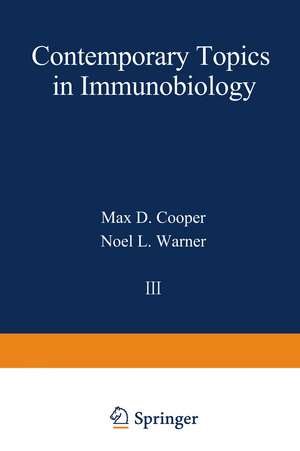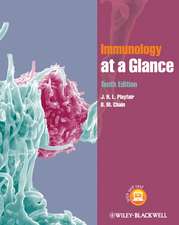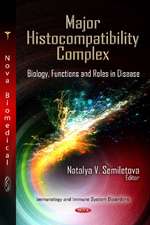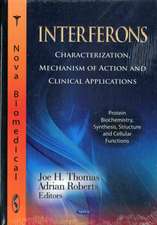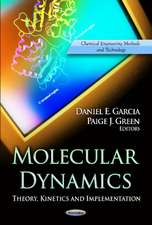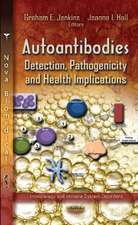Contemporary Topics in Immunobiology: Volume 3
Editat de Max Cooperen Limba Engleză Paperback – 19 mar 2012
Preț: 367.28 lei
Preț vechi: 386.61 lei
-5% Nou
Puncte Express: 551
Preț estimativ în valută:
70.28€ • 73.38$ • 58.16£
70.28€ • 73.38$ • 58.16£
Carte tipărită la comandă
Livrare economică 04-18 aprilie
Preluare comenzi: 021 569.72.76
Specificații
ISBN-13: 9781468430479
ISBN-10: 1468430475
Pagini: 284
Ilustrații: XIV, 268 p.
Dimensiuni: 152 x 229 x 15 mm
Greutate: 0.38 kg
Ediția:Softcover reprint of the original 1st ed. 1974
Editura: Springer Us
Colecția Springer
Locul publicării:New York, NY, United States
ISBN-10: 1468430475
Pagini: 284
Ilustrații: XIV, 268 p.
Dimensiuni: 152 x 229 x 15 mm
Greutate: 0.38 kg
Ediția:Softcover reprint of the original 1st ed. 1974
Editura: Springer Us
Colecția Springer
Locul publicării:New York, NY, United States
Public țintă
ResearchCuprins
1. T Cell Control of Antibody Production.- Evidence for a Suppressor Effect of T Cells.- Suppressor Macrophages.- Suppressor Animals.- Interactions Between T Cell Subpopulations.- Subclasses of B Cells.- Meaning of “Thymus Independency”.- T Cell Discrimination of Signals.- Do Tolerant Cells Exist?.- Meaning in Life.- Possible Models.- Summary.- Abbreviations.- Acknowledgments.- References.- 2. Short-Term and Chronic Allotype Suppression in Mice.- Short-Term Allotype Suppression.- Chronic Allotype Suppression.- Mechanism of Chronic Allotype Suppression.- Acknowledgments.- References.- 3. On the Relationship Between Cellular and Humoral Antibodies.- Cellular and Humoral Antibodies Produced by B Cells.- Cellular and Humoral Antibodies Produced by T Cells.- Acknowledgments.- References.- 4. T Cell Modification of B Cell Responses to Antigen in Mice.- Experimental T Cell Deficiencies.- “T Cell Independent” Responses of B Cells.- Conclusions.- Abbreviations.- Acknowledgments.- References.- 5. Genetic Control of Antibody Responses to Myeloma Proteins of Mice.- Immunoglobulin Allotypes of the Mouse.- Genetic Control of the Immune Response to BALB/c IgA Myeloma Proteins.- Genetic Control of the Immune Response to BALB/c IgG Myeloma Proteins.- Genetic Control of the Immune Response to BALB/c IgH (?2 b) Myeloma Proteins.- Mapping of Ir Genes in the H-2 Complex.- Function of Ir Gene Products.- Acknowledgment.- References.- 6. Histocompatibility Systems, Immune Response, and Disease in Man.- HL-A and H-2.- H-2 and Murine Leukemia.- Immune Response Genes.- HL-A and Disease.- Leukemias.- Lymphomas.- Immunopathic Diseases.- Genetic Diseases.- Cancer (Other than Lymphomas).- Infectious Diseases.- HL-A and Immune Responses.- Nature of Association Between HL-A and Disease.-References.- 7. Antigen-Binding Receptors on Lymphocytes.- Methods for Measuring ABC.- ABC in Nonimmune Animals.- ABC in Immune Animals.- ABC in Tolerance.- Summary.- References.- 8. Modification of B Lymphocyte Differentiation by Anti-immunoglobulins.- Suppression of First Stage B Lymphocyte Differentiation: In Vivo Models.- Suppression of Second Stage Differentiation by Anti-Immunoglobulins: In Vitro Models.- Conclusion.- Acknowledgments.- References.- 9. The Roles of T and B Lymphocytes in Self-Tolerance and Autoimmunity.- Tolerance in T and B Lymphocytes.- T Cell Helper Effects in Immune Responses.- Autoantigen-Binding Lymphocytes in Normal Subjects.- Allogeneic Cell Stimulation, Adjuvants, and Autoantibody Formation.- Control of Immune Responses by T Cells.- Congenital Virus Infections.- General Comment.- References.- 10. Immunological Studies of Nude Mice.- Genetics.- Cellular Defects.- Response to Mitogens.- Mitogenic Response to Allogeneic Cells.- Mitogenic Responses to Antigens.- Antigen Binding.- Immunoglobulin Levels.- Response to Thymus Independent Antigens.- Response to Thymus Dependent Antigen.- Contact Sensitivity.- Cell Mediated Cytotoxicity.- Skin Grafts.- Tumor Grafts.- Spontaneous Tumors.- Effect of Mitogens on Antibody Production In Vitro.- Effect of Thymocytes and Thymus-Derived Cells on Antibody Production In Vitro.- Thymus Grafts In Vivo.- Comments.- Acknowledgments.- References.
